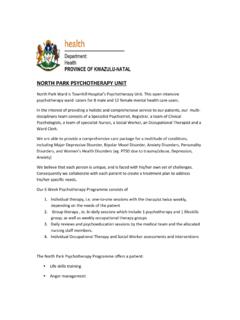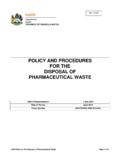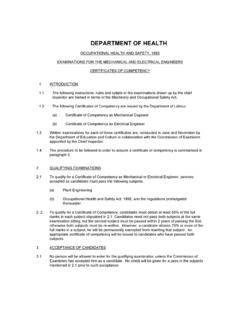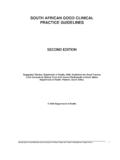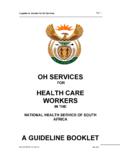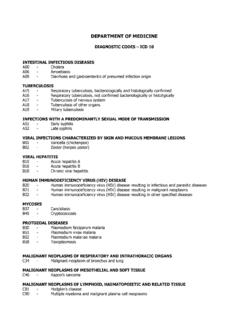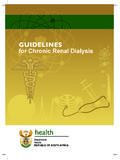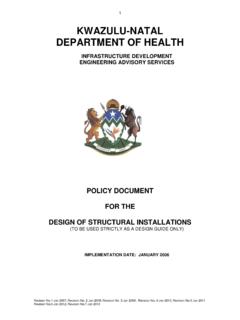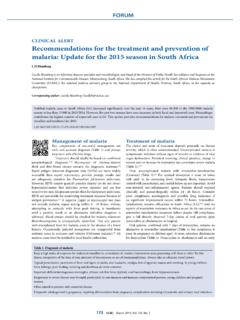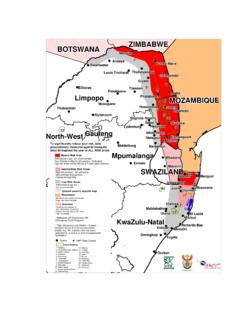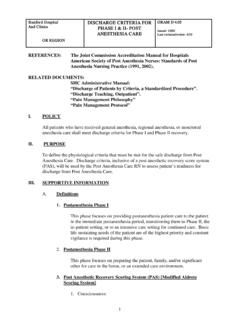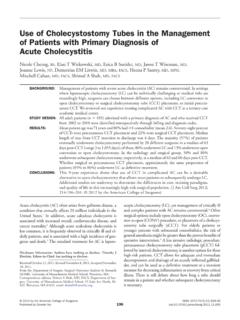Transcription of Management of aggressive and disruptive patients
1 EDENDALE hospital . DEPARTMENT OF MEDICINE. APRIL 2007 PROTOCOL: Management OF aggressive AND disruptive patients . Rationale: This aim of this policy is to ensure the appropriate Management of patients with aggressive or agitated behaviour in accordance with the Mental Health Care Act (MHCA) of 2002. Procedure: patients should be triaged and managed in Medical Admissions or the Resuscitation Room by the most senior doctor present: see Appendix 1 for flow chart, Appendix 2 for sedation regimen, and Appendix 3 for a full list of the MHCA forms. patients can be admitted under four different circumstances: 1. Voluntary: the patient agrees to admission for assessment and sedation 2. Assisted: the patient does not agree to admission but a family member is able agree to admission. Forms MHCA 04 (signed by any family member) and two MHCA 05 (signed by the admitting doctor and another healthcare worker who need not be a doctor) and MHCA 07 must be completed at the time of admission. 3. Involuntary: the patient does not agree to admission and is sedated for the safety of him/herself and the community.
2 Forms MHCA 01, MHCA 04 (signed by any healthcare professional) and two MHCA. 05 (signed by the admitting doctor and another healthcare worker who need not be a doctor) and MHCA 07 must be completed at the time of admission. The ward doctor must complete form MHCA. 06 after 72 hours and MHCA 03 at the time of discharge. 4. Emergency: the patient requires immediate specialised psychiatric care and is transferred to Town Hill hospital after discussion with the psychiatrist on call. Complete forms MHCA 01, 04, 05 (signed by two healthcare workers), 07, 06 and 11. Note that: The purpose of the 72-hour observation period is to rule out a medical cause for altered mental status (General Medical Cause). A medical cause for change in mental status can be ruled out using the observations listed in Appendix 1, Step 3. A 72-hour observation period may not be necessary if the patient has previously received a psychiatric diagnosis, and is presenting with a relapse of symptoms [MHCA. Chapter 5, Sec.]
3 34, Point (4) (a)] the procedure is described in Appendix 4. _____ _____. DR D WILSON DR VK MAISTRY. HEAD, DEPARTMENT OF MEDICINE MEDICAL MANAGER. Reviewed by Dr Jonathan Burns, Chief Specialist, Psychiatry REVIEW DATE: APRIL 2008. 1. Appendix 1: Flow chart for the Management of aggressive or agitated patients Step 1: Patient with disordered mentation: 1. aggressive 2. Destructive 3. Running away from home 4. disruptive and irrational 5. Hallucinating 6. Agitated Step 2: Sedate if patient's behaviour is dangerous or highly disruptive (Appendix 2). 1. Offer sedation to patient: if accepted document this in notes 2. If sedation is refused, or if patient does not have sufficient insight to give consent, sedate patient after gathering sufficient information to complete one MHCA 04, two MHCA 05. (signed by two healthcare workers), and one MHCA 07. Step 3: Assess for features suggesting a delirium:*. 1. Disorientation and incoherent speech 2. Fluctuating level of attention or consciousness 3.
4 History of recent abuse of alcohol 4. History of recent seizures or head trauma 5. RR >24, HR >100, Temp >38oC or <35oC, O2 saturation <94% in room air 6. WCC < or >12, Ur >8, glucose >12 or <3, abnormal Na, K, or Ca 7. Abnormal cardiorespiratory or abdominal examination 8. Meningism or abnormal CSF analysis 9. Focal CNS signs 10. Asterixis Step 4: Delirious: Not delirious: 1. Diagnose underlying condition 1. Admit with a working psychiatric 2. Start appropriate treatment for diagnosis ( brief psychotic both the medical condition and episode, schizoaffective disorder, the behavioural disturbance mania). 2. Ensure that appropriate medication is prescribed 2. *Mnemonic for causes of abnormal / agitated behaviour Metabolic: Renal / liver failure; electrolyte abnormalities; abnormal glucose;. Oxygen: Hypoxaemia Vascular: Stroke, sub-arachnoid bleed or vasculitis Endocrine: Abnormal thyroid hormones; abnormal cortisol Seizures: Post-ictal state Trauma: Concussion; sub-dural or extra-dural bleed Uraemia: Renal failure Psychiatric: Primary psychiatric disorder Infections: Pulmonary, urinary, cellulitis, meningitis, sinusitis, cholecystitis, osteitis Drugs: Alcohol withdrawal, recreational, non-adherence to psychiatric treatment 3.
5 Appendix 2: Sedation of aggressive and agitated patients [Adapted from Psychiatry policy, with input from Dr F Khan]. 1. Offer sedation to patient: if accepted document this in notes. Consider offering oral sedation if appropriate. 2. If sedation is refused, sedate patient after gathering sufficient information to complete one MHCA 04. form, two MHCA 05 forms and one MHCA 07 form. Ensure these forms are completed as soon as possible. 3. If parenteral sedation needs to be given and patient is unable to cooperate: Call 6 assistants: Five security guards one for each limb and one for head/shoulders One doctor/nurse to assist with administering sedation 4. Give the following medications: a. Lorazepam 4-8mg IVI / IMI. b. Haloperidol 10 20 mg IVI / IMI. 5. Ensure that patient is fully sedated so that restrains are unnecessary 6. Prescribe maintenance sedation with lorazepam and haloperidol to be given 3 6 hourly in order to ensure that the patient is sufficiently sedated so that the functioning of the ward is not disrupted.
6 7. Vital signs should be monitored 2 6 hourly depending on the patient's level of sedation, and should be prescribed on the Department of Medicine Communication Chart. 8. Sedation should not be stopped until the ward doctor has reassessed the patient. 9. Hydration and nutritional status should be regularly assessed and fluids and feeds provided accordingly. 4. Appendix 3: Summary of the MHCA forms [provided by Dr H King, Townhill hospital ]. Forms are kept on the counter in Room J. 01---Emergency admission or treatment without consent report to mental health Review Board---MHCP and HCP or HHE. 02---Report on exploitation, physical or other abuse, neglect or degrading treatment of a mental health care user---Person who witnessed abuse. 03---Discharge Report---Filled by ward doctor and signed by HHE. 04---Application for assisted- or involuntary care, treatment and rehabilitation---filled in by spouse, guardian, next of kin, HCP, partner, parent, associate---preferably done by Social Worker---must sign under oath.
7 05---Examination and findings of MHCP x2 following an application for assisted- or involuntary care, treatment and rehabilitation----1 filled by ward Sister and 1 by ward Doctor. 04 and 05--- cannot be filled by one person. 06---72-hour assessment and findings of MP or MHCP after HHE has granted application for involuntary care, treatment and rehabilitation---filled by ward Doctor. 07---Notice by HHE on whether to provide assisted- or involuntary inpatient care, treatment and rehabilitation- --HHE. 08---Notice by HHE to RB requesting approval for further involuntary care, treatment and rehabilitation on an inpatient basis---HHE. 09---Notice by HHE after 72-hour assessment period informing RB that MHCU warrants further involuntary care on an outpatient basis---HHE. 10---Transfer of involuntary MHCU schedule of conditions relating to his or her outpatient care---filled by ward Doctor and signed by HHE, MHCU and custodian. 11---Transfer of involuntary MHCU on an inpatient basis to psychiatric hospital ---filled by ward Dr and signed by HHE.
8 12---goes together with Form 10---Transfer of involuntary MHCU from inpatient to outpatient care and vice versa---filled by ward Dr and signed by HHE. 13A---Periodical report no. on MHCU (assisted/involuntary user/mentally ill person)---filled and signed by ward Dr and also signed by HHE. 14---Decision by RB concerning assisted mental care; appeal against decision of HHE concerning assisted care; further involuntary care on an inpatient basis; appeal against decision of HHE on involuntary care--- filled & signed by RB. 15---Appeal to RB against decision of HHE on assisted-or involuntary mental health care---filled & signed by a p p e l l a n t. 16---Order by High Court for further treatment and rehabilitation/discharge of an involuntary MHCU on an inpatient basis---filled & signed by Registrar of the High Court. 17---Decision by RB following periodical report on assisted- or involuntary MHCU's and mentally ill prisoners filled & signed by RB. 18---Summons to appear before a RB---filled & signed by RB.
9 19---Request by HHE to RB to transfer an assisted- or involuntary MHCU to maximum security facilities; a State patient between designated HE's ; a mentally ill prisoner between designated HE's. 20---Order by RB to transfer an assisted- or involuntary MHCU to maximum security facilities; a State patient between designated HE's; a mentally ill prisoner between designated HE's----RB. 22---Handing over of custody by the SAPS of a person suspected of being mentally ill or severely or profoundly intellectually disabled and likely to inflict serious harm---filled & signed by SAPS member. 25---Notice of Abscondment to SAPS and request for assistance to locate, apprehend and return MHCU--- filled by ward Sr or Dr and signed by HHE. 26---Notice of return of absconded user to the HE---filled by ward Sr or Dr and signed by HHE. 27---Leave of absence to State patients ; or assisted- or involuntary MHCU's---filled in by ward Sr or Dr and signed by HHE. 28---Cancellation of leave of absence a State patient; an assisted- or involuntary MHCU---filled in by ward Sr or Dr and signed by HHE.
10 47---Register---Record of Electro-Convulsive treatment---filled & signed by Dr. 48---Register---Record of Seclusion---filled and signed by Dr. 5. Appendix 4. Procedure for transferring psychiatric patients directly to a psychiatric hospital under Mental Health Care Act Chapter 5; Section 34; Point (4) (a). A patient can be transferred directly to either Fort Napier hospital or Town Hill hospital if the following conditions are met: 1/ The patient presents with disordered behaviour, and history is obtained from a credible source ( family member, neighbour) that this patient's behaviour has been similarly disordered in the past, and has received treatment from Fort Napier or THH, and has relapsed (with or without non-adherence to therapy). 2/ An expedited medical work-up is negative (Clinical: vital signs stable; cardiorespiratory and abdominal exam normal; no meningism or focal neurological signs; no significant injuries. Laboratory: FBC, white cell diff; urea, electrolytes, ALT, INR; CXR and CSF (if indicated: see lumbar puncture policy) are normal).
